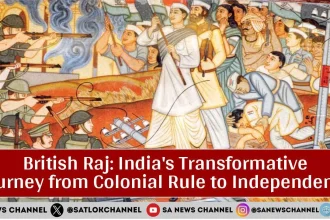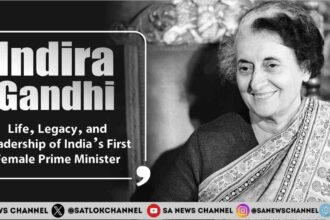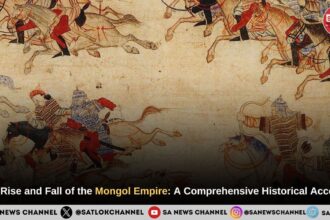Long before European settlers arrived, the American West was home to a vast and diverse population of Indigenous peoples. Tribes such as the Apache, Navajo, Ute, Shoshone, Sioux, and Comanche occupied regions that spanned the Great Plains, Rocky Mountains, and desert plateaus. These tribes developed unique cultures, economies, and spiritual systems tailored to the geography and resources around them.
- Spanish Exploration and Colonization
- The Role of the Louisiana Purchase
- Westward Expansion and Manifest Destiny
- The Gold Rush and California Statehood
- Native American Displacement and Conflict
- The Role of the Railroad
- The Rise of the Cowboy and Cattle Industry
- Settlement of the Great Plains
- Mining, Law, and Order
- Women’s Role in the American West
- The Closing of the Frontier
- Cultural Myths and the Wild West
- Industrialization and Urban Growth
- A Region of Diversity and Change
- Spiritual Perspective: Western Spiritual Landscape and the True Devotion Explained by Sant Rampal Ji Maharaj
- FAQs on the history of the American West
The Plains tribes, for example, relied heavily on the buffalo for food, clothing, and shelter, while Southwestern tribes like the Puebloans built sophisticated adobe cities and practiced agriculture in arid environments. These societies were not static; they evolved over centuries and often traded, fought, or allied with one another long before Europeans arrived on the continent.
Spanish Exploration and Colonization
The first European to explore what is now the American West was Spanish conquistador Francisco Vásquez de Coronado, who in the 1540s led an expedition across present-day Arizona, New Mexico, Texas, Oklahoma, and Kansas. Hoping to find the fabled Seven Cities of Gold, Coronado and his men encountered various Native American tribes but found no riches.
Despite this, Spain continued to establish missions and forts throughout the Southwest during the 17th and 18th centuries. These missions, run by Franciscan friars, aimed to convert Native peoples to Christianity and integrate them into Spanish colonial society. The Spanish also introduced horses, cattle, and new agricultural practices, which would later transform Native cultures, especially among Plains tribes who adopted horse-based nomadism.
The Role of the Louisiana Purchase
The American West began to take shape in the national imagination with the Louisiana Purchase of 1803, when President Thomas Jefferson acquired over 800,000 square miles of territory from France. This vast tract of land doubled the size of the United States and opened the way for exploration and expansion west of the Mississippi River. To understand and chart the new territory, Jefferson commissioned the Lewis and Clark Expedition in 1804.
Their journey to the Pacific Ocean, completed in 1806, provided valuable information about the region’s geography, flora, fauna, and native inhabitants. It also laid the groundwork for future American claims to the Pacific Northwest.
Westward Expansion and Manifest Destiny
The early 19th century marked the beginning of rapid American settlement into western lands, driven by the belief in Manifest Destiny, the idea that the United States was divinely ordained to expand from the Atlantic to the Pacific. This ideology became a powerful motivator for pioneers, politicians, and settlers who viewed the West as a land of opportunity and freedom.
The federal government supported this expansion through land grants, military campaigns against Native tribes, and treaties that were often broken or forced.
Also Read: From Colonies to Superpower: The American History
Key milestones included the annexation of Texas in 1845, the Oregon Trail migrations, and the Mexican-American War, which resulted in the 1848 Treaty of Guadalupe Hidalgo and the acquisition of California and much of the Southwest.
The Gold Rush and California Statehood
In 1848, gold was discovered at Sutter’s Mill in California, igniting a massive rush of fortune seekers from around the world. By 1849, over 300,000 people had arrived in the region, a group collectively known as the “Forty-Niners.” The California Gold Rush not only transformed the local economy but also accelerated the push for statehood.
California was admitted to the Union in 1850 as part of the Compromise of 1850. However, the rapid influx of people led to the displacement and violence against Indigenous populations, environmental degradation, and the establishment of boomtowns that would later become major cities like San Francisco and Sacramento.
Native American Displacement and Conflict
As American settlers moved westward, conflict with Native American tribes became inevitable. The Indian Removal Act of 1830 had already displaced thousands of Native people from the southeastern U.S. to the so-called “Indian Territory” west of the Mississippi. But the expansion into the Great Plains and beyond led to a new series of conflicts.
The U.S. Army engaged in numerous campaigns against tribes who resisted displacement, leading to a series of tragic events such as the Sand Creek Massacre (1864), the Battle of the Little Bighorn (1876), and the Wounded Knee Massacre (1890). Reservations were established to confine Native populations, and traditional ways of life were systematically dismantled.
The Role of the Railroad
The completion of the Transcontinental Railroad in 1869 revolutionized the American West. Connecting the existing eastern rail network with the Pacific coast, the railroad made travel faster, safer, and more economical. It allowed settlers to move west in greater numbers and enabled the shipment of goods, livestock, and raw materials to distant markets.
The railroad companies received large land grants from the government and often sold land to settlers at low prices, further encouraging migration. However, the construction of the railroad had significant consequences for Native communities, whose lands were traversed or seized without consent. It also contributed to the near-extinction of the buffalo, a keystone species for many Plains tribes.
The Rise of the Cowboy and Cattle Industry
One of the most enduring symbols of the American West is the cowboy. After the Civil War, the cattle industry boomed as demand for beef grew in the urbanized East. Texas ranchers drove massive herds of cattle north to railheads in Kansas and Nebraska, where the animals were shipped to slaughterhouses in Chicago and beyond.
These cattle drives gave rise to the cowboy culture, with its unique dress, language, and skills. Cowboys were often young, diverse in background, and worked grueling hours in difficult conditions. While Hollywood would later romanticize their lives, the reality was far more complex and labor-intensive. The open range system eventually gave way to fenced-in ranching as barbed wire and private land claims ended the era of free grazing.
Settlement of the Great Plains
The Homestead Act of 1862 played a crucial role in the settlement of the Great Plains. It granted 160 acres of public land to any citizen or intended citizen who would live on and improve the land for five years. This offer attracted hundreds of thousands of settlers, including immigrants from Europe and freed African Americans known as Exodusters seeking a new start after the Civil War.
Farming the Plains was difficult due to harsh weather, droughts, and the lack of trees for building materials. Still, settlers built sod houses, developed dry-farming techniques, and formed tight-knit rural communities. Over time, these efforts transformed the region into one of the most productive agricultural zones in the country.
Mining, Law, and Order
Mining was another major driver of Western expansion. After the California Gold Rush, additional strikes occurred in places like Colorado, Nevada, Montana, and the Dakotas. These booms brought waves of miners, speculators, and businesses hoping to profit from the resource-rich lands. Towns sprang up almost overnight, some of which quickly faded when the minerals ran out. Others, like Denver and Butte, evolved into major cities.
The rapid population growth often outpaced the establishment of formal legal systems, leading to lawlessness, vigilante justice, and infamous outlaws like Jesse James and Billy the Kid. Eventually, local and federal authorities established law enforcement structures, but the period left a lasting imprint on the mythos of the American West.
Women’s Role in the American West
Women played critical roles in shaping the American West, though their contributions were often overlooked in traditional histories. Frontier women worked alongside men in farming, ranching, and business. Some served as teachers, nurses, and journalists, while others ran boarding houses or general stores.
In mining towns and on the frontier, women often faced harsh conditions but also experienced unique freedoms not available in the more rigid societies of the East. The West also became a testing ground for women’s rights. Wyoming was the first U.S. territory to grant women the right to vote in 1869, followed by other Western states, setting a precedent that would influence national movements.
The Closing of the Frontier
By 1890, the U.S. Census Bureau declared that the American frontier was officially closed. Settlement had spread across the entire continent, and few unclaimed public lands remained. Historian Frederick Jackson Turner famously presented his “Frontier Thesis” in 1893, arguing that the frontier experience had shaped American democracy, individualism, and innovation.
While Turner’s ideas sparked debate among scholars, the closing of the frontier marked a turning point. The West was no longer viewed as an open land of unlimited opportunity but as a region in need of modernization, conservation, and integration into the broader national economy.
Cultural Myths and the Wild West
As the frontier closed, popular culture began to romanticize the era. Buffalo Bill Cody’s Wild West shows toured the country and Europe, dramatizing frontier life with staged battles, sharpshooting displays, and reenactments of pioneer life. Western novels, pulp magazines, and later Hollywood films helped cement stereotypes of noble cowboys, savage Indians, and rugged individualists.
These portrayals often simplified or distorted the complex realities of the West, omitting the roles of women, minorities, and the environmental cost of expansion. Nonetheless, the myth of the Wild West became a foundational narrative of American identity.
Industrialization and Urban Growth
By the early 20th century, the American West was undergoing rapid industrialization. Cities like Los Angeles, Denver, and Phoenix grew into major urban centers fueled by oil, mining, agriculture, and real estate. The construction of dams and irrigation systems transformed deserts into fertile farmland, while new highways and airplanes connected remote regions to national markets. The federal government invested heavily in infrastructure, including the Hoover Dam and Route 66. These developments brought prosperity but also environmental challenges, such as water shortages, air pollution, and the displacement of rural communities.
A Region of Diversity and Change
The American West today is one of the most culturally diverse regions in the United States. Its population includes descendants of Native tribes, Hispanic communities with roots dating back to Spanish colonization, Asian immigrants who helped build the railroads, and African Americans who migrated west during various waves of resettlement. This diversity continues to shape the politics, culture, and economy of the West.
The region also plays a key role in national issues such as immigration, water rights, land use, and environmental conservation. Despite its turbulent past, the American West remains a powerful symbol of resilience, transformation, and the complex story of a nation built on both hope and hardship.
Spiritual Perspective: Western Spiritual Landscape and the True Devotion Explained by Sant Rampal Ji Maharaj
Spirituality in the American West was as diverse and evolving as the land itself. Indigenous peoples had rich spiritual traditions deeply rooted in nature, ancestry, and sacred rituals. Each tribe held unique beliefs, yet many shared a profound reverence for the Earth, animals, celestial bodies, and the interconnectedness of all life. Their spirituality wasn’t confined to temples, it lived in the mountains, rivers, and stars.
As settlers arrived, they brought with them various Christian denominations, including Protestantism, Catholicism, and Mormonism. The West became a land of both missionary zeal and religious experimentation. The harsh realities of frontier life, uncertainty, isolation, survival, drew people toward faith, often blending traditional religion with personal, experience-based spirituality. Revivalist movements, tent preachers, and new spiritual sects emerged, reflecting the hunger for meaning in a raw, expanding world.
However, many spiritual questions remained unanswered. Why did suffering persist even after prayers? Why did even righteous people face injustice? Who is the Supreme God? These questions were often left to individual interpretation or confined within incomplete doctrinal frameworks.
What Chyren Saint Rampal Ji Maharaj Teaches
Sant Rampal Ji Maharaj offers answers to these deep spiritual questions through the lens of authentic scriptures from all major religions. He explains that while the people of the American West were sincerely searching for God, they lacked access to complete spiritual knowledge. The Supreme God, as per the Vedas, Gita, Bible, Quran, and Guru Granth Sahib, is not formless but is Param Akshar Brahm, identified as Kabir Saheb.
According to Sant Rampal Ji Maharaj, the Earth is a temporary world of birth and death, where all souls are entrapped in cycles of suffering under the control of Kaal Brahm (Satan-like figure in scriptures). Liberation or salvation is not achieved through incomplete worship, rituals, or blind faith, but only by receiving Naam initiation from a Tatvdarshi Sant (Enlightened Saint) and chanting the true mantras given by Him.
He emphasizes:
- God is in human form and came as Kabir Saheb, who gave true spiritual knowledge.
- The purpose of human life is salvation, not material success or temporary joys.
- Compassion, non-violence, and truthfulness are foundational virtues for devotion.
- One must verify all spiritual knowledge through holy scriptures.
- Only by chanting Satnaam and Saarnaam (true mantras) as granted by a true Saint, can a soul attain Moksha (liberation) and return to Satlok, the eternal abode.
Sant Rampal Ji Maharaj teaches that true spirituality transcends geography, race, and era. Whether in the plains of America or the villages of India, the soul’s yearning for the Supreme God can only be satisfied through true devotion as prescribed in scriptures. He invites all humanity, including those still searching today, to recognize the Supreme God and embrace the path of true worship for everlasting peace. You can always visit Sant Rampal Ji Maharaj YouTube channel for true Spiritual knowledge.
FAQs on the history of the American West
1. What was the American West?
The American West refers to the vast region west of the Mississippi River that was explored, settled, and developed primarily during the 19th century.
2. Who lived in the West before American settlers?
Native American tribes, such as the Apache, Sioux, Navajo, and Comanche, lived across the region with rich and diverse cultures long before European or American expansion.
3. What sparked the California Gold Rush?
Gold was discovered at Sutter’s Mill in 1848, attracting thousands of fortune seekers from around the world by 1849.
4. What was Manifest Destiny?
Manifest Destiny was the belief that the United States was destined to expand across the continent, justifying westward migration and territorial conquest.
5. How did the railroad affect the West?
The Transcontinental Railroad, completed in 1869, connected the East and West, boosting migration, trade, and settlement while impacting Native lands and economies.









